I've had a dog for close to ten years now, and he has been with me on almost every single fishing trip I've been on since I got him.
There's no doubt that my all times best fishing friend is my very close friend Henning - two legged, very human and always great company when we go out together, not least now where I need some practical help in order to get in or even near the water. Henning is helpful and patient and I couldn't ask for better company.
But second on the list and a very good companion on any fishing trip is my dog Divus (The name is the male form of Diva, pronounced Deevus). People who read my articles on this web site regularly or listened to my podcasts back when I made them will have met my furry friend a few times already, but this article is about him - and a little about fishing with the company of a dog in general.
A Sheltie
Divus is a Shetland Sheepdog, a medium size dog (about 10 kilos or 20 lbs.) and out of a fairly old sheep herding race, originally from... yes, you guessed it: Shetland. The appearance of Shelties as they are often called is much like that of a collie (think Lassie), but just smaller, and it's a very general misconception that Shelties are just small collies. Not so. They are a race in their own right.
Having a sheepdog or a dog of a herding breed has several advantages, and we originally chose to get a Sheltie for those reasons:
- They are generally bright dogs with a good intelligence.
- They are easy to teach things and have a "high bandwidth" and a "large vocabulary".
- They are loyal dogs, that won't stray, but mostly follow you close and stay where you put them.
There are differences between herding dogs. Dogs like Border Collies are very active and quite demanding, but also extremely intelligent and very willing to work. They are probably the world's most common working dog, herding sheep all over the globe.
Another well known herding race is the German Shepard also known to be easy to work with, and widely used as a police and guard dog everywhere.
Shelties are not quite as active as Border Collies, but still very willing to work and a race that's often seen in agility competitions, where dogs must finish obstacle courses on time. But a Sheltie can still relax and lie quietly indoors for a long time. Shelties are known to bark quite a bit, and even though we think Divus barks a lot, he is actually a quiet Sheltie.
Easy
Divus is an easy dog, and can be without a leash at all times - in the city where there's a lot of traffic and even when I'm in the water. He can be ordered to stay on the bank or beach, and will largely stay there, or at least neither run away nor follow me into the wet elements. Divus is not a swimming dog. He will go into the water on command, and even swim, but being a very furry creature he soaks up immense amounts of water, and I usually carry him if it's too deep where we need to cross.
He will also usually stay calm when I leave him or when strangers approach. He can be commanded on the distance to sit or to lie down, for instance when I'm in the water and the dog is on the beach or bank. I can get him to go in a certain direction by pointing and he comes when I call.
At home in the city when I go shopping I can ask him to sit outside the shop without a leash, and he will stay there until I'm done and come out again.
This is all something that we have trained quite intensely from he was small, but also something that is inherent in the race, which is a calm and very loyal herding race, bred to be alert, attentive and obedient. You shouldn't expect any dog to be as well behaved, but you can do a lot to get your dog to behave by being out early and being consequent.
A puppy at the water
Teaching him to behave at the water has been a long process, which started back when he was less than two months old. He was with me fishing just a week after he arrived in our house. He managed to pee in the lap of my fishing friend Lars on the way, but it was also a long trip.
Once we arrived at the water I did what I usually do: rig my rod, don my waders and go along the beach to find a place to fish. Divus was right behind me all the time. Being a small puppy he was very anxious not to get lost, and followed close in my heels. When I entered the water he'd stay on the dry, but with the front feet in the water, whining a bit but staying and watching. I'd stay close to the shore and keep contact with him all the time, returning regularly to praise him for his good behavior and spend some time petting and playing.
The first many trips were like this. I never went far, and he got lots of attention and snacks for behaving well. He would mostly stay on the beach right where I was fishing, but also sometimes go back to sit or lie near our stuff, placed on the beach, and I could slowly move further out and farther away from him. Being a puppy he also needed to sleep regularly, which is not at all a bad trait in a good fishing partner, motivating me to sit or lie down and relax.
Growing up
As Divus grew up we trained him quite intensely and demanded more and more, but still praising and making sure that it was a good and fun experience. The whole family attended dog training and we made sure that we agreed on the "language" and signs we used, which of course made things easier for all. These signs and commands are also the ones used by most dog owners, so a lifted finger means sit and a flat hand means lie down, and the place to go when asked is to sit on the left hand side close to the commander's legs. It's really pretty useful when your dog can be commanded by others.
By the water he grew more independent and would stray a bit and explore, sometimes disappearing out of sight but always returning with regular intervals and always appearing in sight now and then. After having explored he will often return and sit on the beach right where I am fishing. If I move, he moves too and sits down again.
In the ten years we have had him he has run off one or two times where we have had to follow him to get him back - both times in the pursuit of lady dogs. A very comprehensible motive.
Growing up and being male made him develop a natural sense of responsibility. He likes to guard things and bark when people approach. He's a self-confident male dog with a fairly large ego, and doesn't shy away from larger dogs or people He never causes any harm, but will sometimes get up and bark quite a bit when people approach. It's a small issue, which even has its advantages when we leave bags, cameras and rods unattended. He will be there and be quit noisy if someone comes too close.
A dog in the backcast
I have been fishing with GFF partner Steve and his border collie Brookie, also an easy dog to bring on a fishing trip, but a dog that thinks a fly line in a backcast is something to play with. Brookie would stay right under the line and jump up and try to snap it when it passed, leading to several broken off flies and a regular ritual in the garage upon return, where Steve would remove a few flies from Brookie's fur and ears!
Divus also likes to stay right behind the angler, which places him under the line. He won't try to grab it, but staying under the lines of people with low backcasts has cost him a couple of piercings. Nowadays he wisely moves away when he hears the line in the air above him.
Fly tying material
Being a long haired and furry dog gives him another advantage: he's a fly tying material supplier. I have tied many flies from his excellent fur over the years, and he has delivered hair to coastal flies of different kinds and not least a ton of Sunray Shadows, which his long, soft black and white fur is perfectly suited for.
He doesn't exactly enjoy being trimmed for fly tying supplies, which probably reminds him of baing combed and brushed, which he hates. On the other hand a quick snip with a pair of scissors doesn't do much harm, and leaves his fur with no visible traces. There's plenty, and several fly-tying friends have been supplied with both materials and finished flies delivered fully or partly by Divus.
I have written an article on the Sunray Shadow tied with Divus' hair.
We're getting old
Both Divus and I are getting old in each our way. He's literally becoming an old dog, and even though dogs of his size and breed typically grow to 12-15 years and even more, we have to assume that he is past his prime. The same thing can be said for myself. Not that I plan for any of us to pass on right away, but being 54 years old with a pretty severe, chronic disease does mean less activity and less fishing, so we have both geared down a bit, and don't mind lying down more than we stand.
I sail when fishing using a pontoon boat or a kayak, and Divus either stays on the beach or sails with me for short stretches. He doesn't necessarily like the sailing, but it's better than being left on dry land when I sail off.
An example
This is not going to be a course in dog training, but just an example of how we raised and trained Divus to be a fairly well behaved dog.
Sitting outside shops without a leash.
- When he was small I would take him with me to the baker almost every morning.
- He was without a leash, and being an insecure puppy, he followed close in my heels.
- I would put on a leash and tie him to a post right outside the shop and ask him to sit.
- I would use the same command every time: the Danish word for "stay" and an index finger pointing upwards.
- Returning from the shop I would praise him for sitting and being calm and feed him a small corner of my morning croissant.
- When he grew bigger we would do the same. I would put the leash on him, but just leave it lying on the ground.
- I would go in, keep an eye on him through the baker's windows, and get out quickly, praising and rewarding him.
- If he had moved, barked or shown interest in other dogs, I would simply ignore it, not yell or scold him, but not praise or reward him either, but simply take off the leash and start walking home.
- Finally I would just ask him to sit, no leash or anything, and of course praise and reward him for waiting for me.
- In the end I would prolong my stay in the shop, go into larger shops, leave him in front of places where he'd never been before and in all ways challenge him, always praising and rewarding good behavior and simply ignoring bad behavior.
- Nowadays he can be sat in front of any door or almost anywhere, and asked to stay, he'll stay there for 20 minutes and probably longer, and rarely needs a treat as a reward, although he oftentimes gets one.
It took about a year from starting this when he was very small until I was sure that he would stay, but nowadays, many years later, this pattern sits so firmly in him, that I can easily leave him almost everywhere, and be sure he won't react to traffic, other dogs, kids or anything. He sometimes moves, but mostly to get a better view of the door where he expects me to come out.
Fishing dog gallery
I would love to add more fishing dog portraits, so if you bring your dog fishing and have a good picture or two of it by the water, please feel free to mail them to me, and I will add them.
Caddis
Lindsay Ryba from the US sent me a mail:
These are older pictures of a great dog I had years ago. This is "Caddis" a female springer spaniel. The second one in my life, and the first in my adult life.
One of five springer spaniels that I have had the privilege and the pleasure to share many great days in the water and the woods.
I got her name from Gary Borger who wrote an article about a cat he owned with the same name because it had the perfect natural color dubbing that he used for a caddis fly he tied.
I'm glad he didn't name his cat bald, it may have self-incriminated him.
UKC dogs need unique names to be registered, and by coincidence of the arrival of the puppy and the story, the name stuck.
If I was on the water, she was with me at all times. She was as much of a fisherman as she was a bird dog. She learned to anticipate the surface strikes of trout. She would study the end of the fly line in the water, and when the bite was on, she would jump in and swim to help land the fish.
This was entertaining when the fish were common, but things would get a little hectic if I suddenly realized this was going to be a great fish I must land.
If we didn't have a boat she would run alongside the river bank or, if the water was shallow, she would swim in behind me and stand upright behind my legs, with her paws on my lower back. She would lean her head out and around the side of me watching and waiting for a strike. I wish a picture of this scene was captured, but most of the time it was just me and her without a photographer.
Fall was our favorite time of year because we could bird hunt for grouse and woodcock around the same rivers we fished and then grab a flyrod to fish for large browns and brook trout in mid-afternoon. Those were great days. She was a tough bird dog, and without training, & contradicting to her blood line, she would point birds that held tight.
Springer's are bred to quickly spring/flush the game, but I was very grateful that she could pin a bird. It gave me an extra advantage. I actually would ponder the thought that I just might be hunting for her, instead of the other way around. She kind of had that attitude. She really didn't "point" she would look at me and then the bird then back and forth, as to say, get ready for my bird.
Dogs have always been a part of my sporting life, as well as part of our family. I wish all of the dogs I have had were still here and I wish they lived as long as we do.
They have a great depth of soul, if you are sensitive enough to make an awareness of it.
Thanks to George, Caddis, Shannon, Rugger and T Bone.
Thanks
Lindsay Ryba
Sam and Frits
I got a mail from Arjan from The Netherlands:
My name is Arjan de Vries, from Holland.
I'm a big fan of your website since I discovered it in 2010. The fishing dog story moved me and the story sounded very familiar. My girlfriend is the happy owner of two dogs, a dachshund named Frits and a border collie named Sam.
Frits loves to swim, especially in the Danish sea and he's very seaworthy. We've bought a safety suit for him because he swims over 30 meters from the shore at times. A disadvantage is that he is very loud barking at the seaside, to the waves, seaweed etc. He must have spooked many seatrout before I got a chance to cast at them.
I have a great video (bad quality, though) in which I am in the sea near Helnaes firehouse with a seatrout hooked. Frits comes up, swimming, and starts following the running seatrout.
Sam is a lovely dog, as in your story, he guards my fishing bags while I am wading. And he walks up to the water when I start fishing and always greets me when I return out of the water. Just a touch with his nose and a wiggle with his tail and we're back together again, as he likes that very much.
Sam prefers to keep to group together as a border collie is supposed to do. One day, I was fishing the North tip of Fyns Hoved and Sam joined me. My girlfriend walked, taking Frits with her, above us, on the cliff.
While I was preparing to enter the water i heard a rock fall from the cliff. I looked up and just saw Sam's tail go over the cliff!! He climbed the cliff. There is a low point at the north side were you can, if you dare, climb the cliff. It must be 5 meters more, maybe higher.
Sam is nine years old now, and suffered some sort of stroke, in May 2013. But he is looking handsome as ever and almost always joins me fly-fishing for pike, zander, bass etc.
I was never a dog lover until I've met my girlfriend and these two guys.
- Log in to post comments













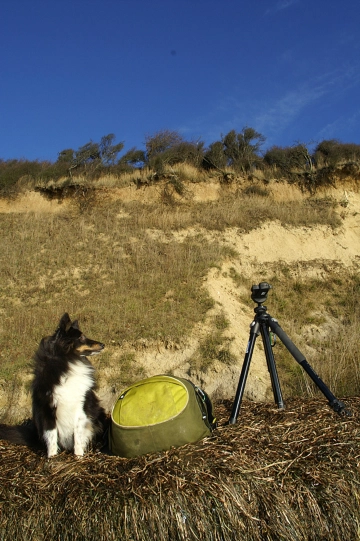











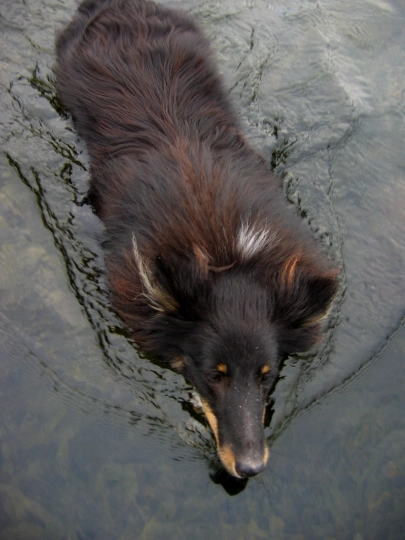

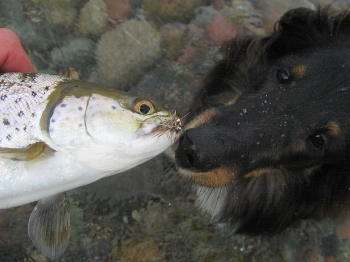








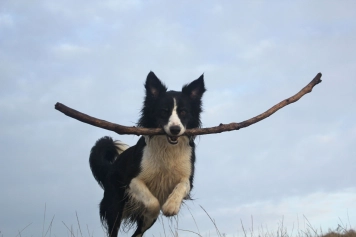

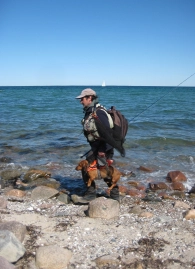
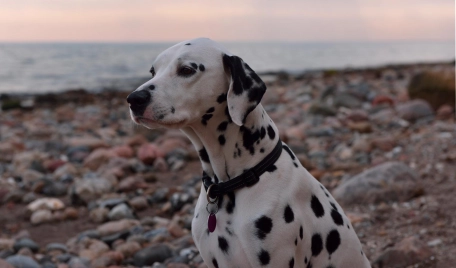







One of the finest an
One of the finest and most adorable stories, I've ever read. And, fortunately, I've met both Martin and Divus a couple of times, when visiting "my home-water", western Sealand. Thank you for sharing 10 years of breathtaking adventures and friendship, hope to see both of you again, soon.
/Jan.
Very nice article Ma
Very nice article Martin. A life without a good friend, like a dog or a cat is an empty life for some people like me.
I had a cat for "22" years that behave like a good trained dog, it was waiting for me in the hall when I came home and when I was doing something in the house or in the garden he was always with me.
I have never take him with me fishing, but he was a serious fishing cat in the garden pond!!!!!
Tom.
damn straight ! mans
damn straight ! mans best friend......unconditional love!! my rottie is very similar in nature! thanks for sharing
What a nice dog. I t
What a nice dog. I took one of mine fishing and she barked and barked. Scared all the trout. I did take Catonna to the Delaware and went through the drive through at McDonalds . She got a burger with no fixings and sucked it down. Every time we go by now, she cries and wants a burger! She has been to the Catskill Fly Fishing Center and has been on the Beaverkill. Catonna has a fishing dog collar with trout on it. My border collies are too crazy to take fishing or in my boats. Although Sam was in the Adirondacks and went down by the river with me.